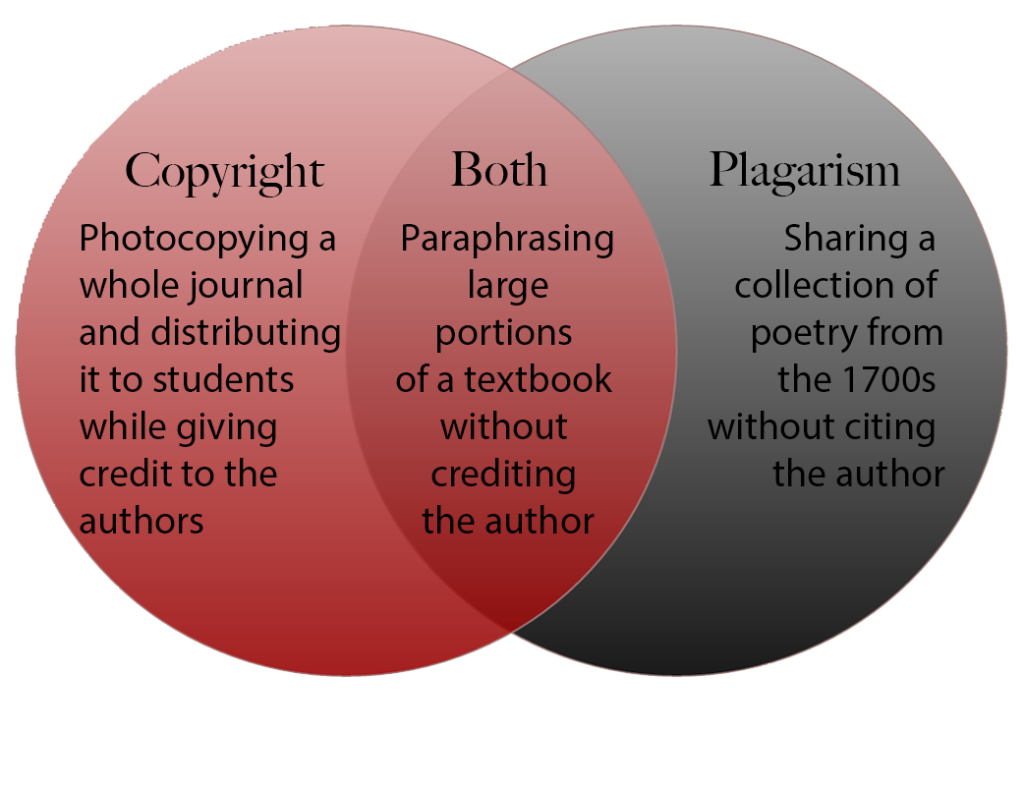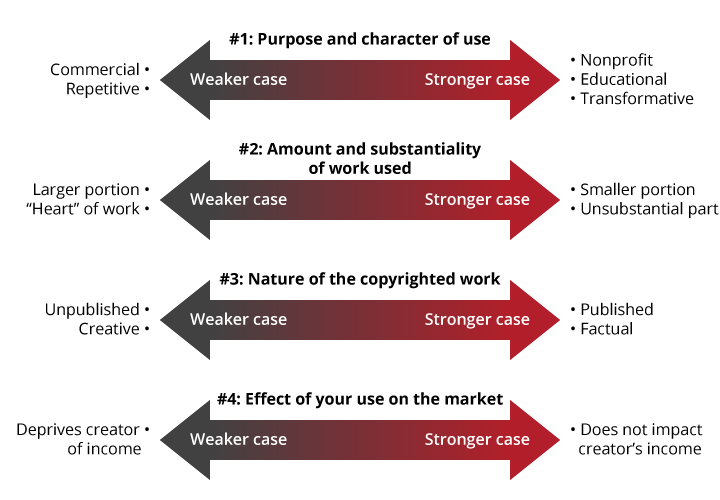Copyright and Plagiarism: The Bare Minimum Instructors Need to Know

Updated: 5/2/2019
Original publication: 11/2/2016
The availability of so much information on the Internet is both a blessing and a curse. It’s a blessing because you have a wide variety of resources you can include in your online classes, but it can be a curse if you don’t know how to include those resources legally and ethically. Although copyright and plagiarism concerns often seem confusing and even burdensome, there are actually several ways instructors can legally share the work of others in their online classrooms.
First, let’s cover some basic definitions.
Copyright and Plagiarism (Yes, There’s a Difference)
Copyright
Did you know that copyright was part of the U.S. Constitution before the Bill of Rights? And that the reasoning behind it was not, in fact, to make instructors’ and students’ lives harder?
In fact, copyright law is meant to encourage the sharing of information (Brigham Young University, n.d.). Let’s think about why that might be true.
Imagine you’ve done some groundbreaking research in your field, but you haven’t decided where to publish it yet. While you’re talking to different journals, someone overhears you and grabs a copy of your notes, and then proceeds to take credit for your discovery and receive all the accolades that should have been yours. The next time you have a breakthrough, are you more likely to share your work or to keep it to yourself rather than risk being taken advantage of again?
Copyright is what protects you and other creators from those types of scenarios. In technical terms, copyright is legal protection for works fixed in a tangible form (United States Copyright Office, n.d.). In other words, copyright doesn’t apply to ideas or thoughts, but the moment you write down or record an original work, copyright law protects it. The work doesn’t need to be published to receive protection; copyright law still applies.
Public Domain
However, copyright protection doesn’t last indefinitely. Unless someone applies for an extension, copyright lasts for the life-span of the creator plus 70 years. After that, the work enters what we call the public domain. Anyone can freely use, copy, manipulate, and distribute works in the public domain without permission from the original copyright holder.
Personally, my favorite example of using a public domain work is Pride and Prejudice and Zombies, in which the author takes the exact words of Jane Austen’s Pride and Prejudice and weaves in a subplot about a zombie apocalypse.
Works created by the U.S. federal government automatically belong to the public domain, and some people create works specifically for public use (more on that later). However, you should always assume that a work is under the protection of copyright law unless it specifically states otherwise.
Plagiarism
Related to but separate from copyright law is the ethical issue of plagiarism. Plagiarism is the act of taking someone else’s work and presenting it as your own without giving credit to the original creator. Plagiarism isn’t a legal issue and thus can be more subjective, but it is something that all academics must pay attention to when handling the work of others.
In general, many acts of plagiarism are also copyright infringements (and vice versa), but this is not always the case (Plagiarism Today, 2013). For some examples, see the Venn diagram below.

How to Legally and Ethically Use the Work of Others
Luckily for educators, several provisions are in place to help you use portions of copyrighted materials in your classroom. Let’s look at the advantages and limitations of each provision, discussed roughly in the order you should consider when deciding how to use a copyrighted work.
Permission
Advantages: The surest protection for using someone else’s work is to ask the copyright holder for permission to use his or her work in your class. After all, the purpose of copyright law is to give creators control over how their works are used, so if a creator is happy to let you use his or her work, then your use will not be a copyright infringement.
Limitations: Obtaining permission can be quite challenging. Sometimes the copyright holder is not immediately evident, or contact information may not be available. And even if you are able to contact the copyright holder, there is no guarantee that he or she will say yes or even respond in a timely manner (if at all).
Linking
Advantages: If you are unable to obtain permission from the copyright holder, you can always provide a link to the original source that you want students to read or view (such as an online article or YouTube video). Because a hyperlink doesn’t create a “copy” of the work, copyright law does not apply to sharing links. Links are simple to insert into your online class, and they allow you to give proper attribution without having to worry about the legality of using another’s work in your course.
Limitations: Some institutions prefer to host all course material on their learning management system (LMS), so linking out to other websites may not be an option. Similarly, instructors must be mindful of the difference between sending students to other websites and embedding other sites’ content within the LMS. Framing is more likely to present a plagiarism problem if instructors do not make it clear that they are not the creators of the content they are including in the course. However, embedding may be permissible if the copyright holder provides the embed code.
In addition, some content on other websites may be behind a paywall or require users to create an account to access it, neither of which are ideal for students who may not want to pay additional fees or create additional accounts.
Fair Use
Advantages: Fair use is a provision in copyright law that allows others to use portions of a copyrighted work for purposes of commentary and criticism (which is often the case in academic settings). Fair use does not require you to obtain the copyright holder’s permission and allows you to copy limited portions of others’ work into your own (with proper references and citations, of course).
Limitations: Fair use is not a blanket excuse to use any amount of a copyright work however you want even if it’s for educational purposes. The question always with fair use is “How much is too much?” But unfortunately, there’s no definitive answer to this question. Instead, it’s better to think of fair use as a sliding scale, and your job is to make the strongest case possible for your use of another’s work. The following graphic summarizes the four factors courts use to determine whether the use of a work is fair (adapted from University of Minnesota Libraries, 2011):
For more on fair use, check out our article Fair Use in More Detail.
The TEACH Act
Advantages: In traditional classrooms, instructors are permitted under copyright law to share copyrighted images, videos, and text during a class session (think of materials you would display on projectors). The Technology, Education, and Copyright Harmonization Act (TEACH Act) sought to specifically address the issue of how this provision applies to online classrooms. The general idea is that online instructors can display some copyrighted materials in their online course as long as the material is secured behind a login (such as an LMS), is directly related to the teaching material, and does not exceed what might be covered in a traditional class meeting (American University Library, 2010).
For example, an instructor may show clips of a feature-length film, but he or she would not be allowed to show the film in its entirely, because that would exceed the length of a traditional class session. Or an instructor may be able to display some images to illustrate a point about art styles in a certain time period, but he or she would likely not be permitted to scan dozens of images from art history textbook. Similarly, an instructor would be able to share portions of a journal article but not the entire PDF (unless he or she borrowed it with the appropriate license from the school library).
Limitations: Instructors must meet several stipulations for their use of copyrighted material to qualify for the TEACH Act (American University Library, 2010; Hoon, 2007):
- The institution must be accredited and nonprofit.
- The use must be under the direction or supervision of an instructor.
- The use must be an integral part of a class session.
- The use must be part of systematic mediated instructional activities.
- The use must be directly related to and of material assistance to the teaching content (e.g., not a decorative image in a PowerPoint).
- The use must be limited to students currently enrolled in the class.
- The instructor must make reasonable efforts to keep students from saving or disseminating the work after the course is over.
- The class must contain a general copyright warning to students using the work(s).
For more on the TEACH Act and how it might apply in your online classroom, check out our article The TEACH Act in More Detail.
Open Educational Resources (OERs)
Advantages: Open educational resources (OERs) are materials that people have created expressly for educational use. OERs typically have an open license, meaning that the creators intend others to use and distribute the work widely without expectation of payment. OERs are becoming more and more creative and innovative along with the rest of the online education industry, so many rich resources are available. Check out our article on how to find quality OERs for your classroom.
Limitations: Finding an OER that fits your specific purposes can sometimes be challenging, especially if you already have a copyrighted work in mind and want an exact replacement. In addition, not every open license is the same; you need to check each individual OER’s license to see the conditions of using the resource.
Conclusion
Copyright law seeks to protect creators so that they can share their works with the public without fear of losing ownership of their creations. Instructors can feel similarly secure sharing copyrighted works with their students once they know the provisions under copyright law that allow them to do so.
For specific examples of copyright issues that instructors often encounter in their online courses, see our article “Copyright Infringement and Plagiarism: Yes, Instructors Can Do It Too.”
References
American University Library. (2010). What faculty need to know about copyright for teaching. Retrieved from https://www.american.edu/library/documents/upload/Copyright_for_Teaching.pdf
Brigham Young University. (n.d.). Module 1: Copyright basics and requesting information. Copyright 101. Retrieved from http://copyright101.byu.edu/module1/page3.htm
Columbia University Libraries. (n.d.). Fair use. Retrieved from https://copyright.columbia.edu/basics/fair-use.html
Gasaway, L. (n.d.). When U.S. works pass into the public domain. Retrieved from http://www.unc.edu/~unclng/public-d.htm
Hoon, P. (2007). Using copyrighted works in your teaching FAQ: Questions faculty and teaching assistants need to ask themselves frequently. Retrieved from http://www.knowyourcopyrights.org/storage/documents/kycrfaq.pdf
Plagiarism Today. (2013, October 7). The difference between copyright infringement and plagiarism. Retrieved from https://www.plagiarismtoday.com/2013/10/07/difference-copyright-infringement-plagiarism/
Stanford University Libraries. (n.d.). Measuring fair use: The four factors. Retrieved from http://fairuse.stanford.edu/overview/fair-use/four-factors/
United States Copyright Office. (n.d.). Copyright in general. Retrieved from http://www.copyright.gov/help/faq/faq-general.html
University of Minnesota Libraries. (2011). Can I use that? Fair use in everyday life. Retrieved from https://netfiles.umn.edu/users/nasims/Share/FairUseforFacultyRev10_2011.pdf

